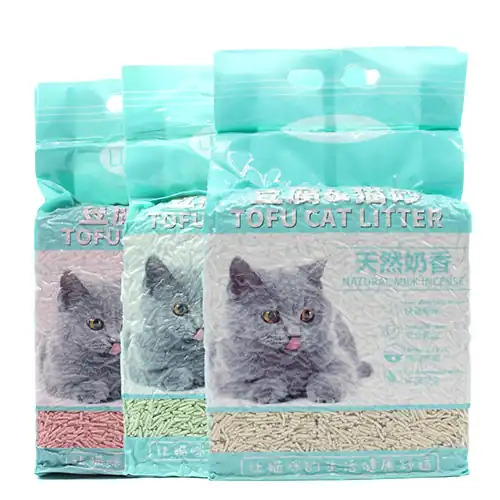What is cat litter?
Cat litter is a litter that absorbs moisture and odors, and is used to absorb or encapsulate feces, urine, and other excretions, and is a common cat product that domestic cats are trained to use in the litter box.
What is the principle of cat litter? Why do cats use cat litter?
Cats’ ancestors were desert animals and used to defecate on sand. When they go to the toilet, they usually have the habit of rubbing the litter and covering their excreta with sand afterward, so the feeling of stepping on the sand-like cat litter is in line with the nature of cats.
Principle of deodorizing cat litter
Odor is produced by a variety of chemical factors, and there are different ways to eliminate odor depending on the chemical factor. Ammonia in cat urine is one of the sources of odor, so it can be neutralized by acid or alkali to reduce the odor, but there are other chemical factors that need to be solved by other means, such as physical adsorption, such as activated carbon and zeolite, and sensory masking, such as the use of fragrances and so forth.
What are the types of cat litter?
There are many types of cat litter available on the market. The most common type is mineral litter, which is the most suitable for cats, and there are also tofu litter, tapioca litter, pine litter, crystal litter, and paper litter, etc. The deodorizing power, amount of dust, and absorbing power of the litter are different for different types of cat litter, so you can make your choice based on the owner’s habit of using the litter and the cat’s acceptance of the litter.
What are the ingredients of cat litter?
The ingredients of cat litter are mainly bentonite clay, which can clump together when wet; tofu litter is made from soybean or pea fibers and other plant starches; woodchip litter is processed from pine and cedar wood chips; and tapioca litter, which is made from natural tapioca, has emerged in recent years.
Why do cats need litter?
If you use your human nose to decipher cat poop and cat urine, you’ll probably only be able to read the “smelly” surface information. But for other animals, it’s full of personal information. That’s why cats go to great lengths to cover up their feces and urine, so as not to publicize their family secrets. Scientists speculate that cats keep a low profile because they want to avoid having their scent tracked by predators.
Another reason is that felines are territorial. Large cats such as lions and leopards use feces to mark their territory, whereas smaller and weaker cats hide their feces and urine so as not to be mistaken for predators. Domestic cats usually regard their owners as the “boss” and will naturally use the litter box at home. However, if the cat considers itself to be the dominant cat or if there are many cats in the house, it is possible that the dominant cat will urinate indiscriminately.
Your cat’s ancestors lived in the desert, and burying feces and urine has long been an uneducated instinct. As an owner, all you need to do is provide your cat with a “desert” – a litter box – when it wants to go to the bathroom. Generally speaking, cats like soft, sandy litter, but each cat has its own preferences, so once you’ve found your cat’s favorite litter, don’t change it arbitrarily to avoid adding to your cat’s distress.
The depth of the indoor desert should be about 5 centimeters. Putting in more litter will not reduce the number of cleanups, and some cats prefer to pick up the sand and feel the smooth bottom of the basin. To minimize pungent odors, the litter box should be cleaned daily, clumps scooped out and refilled with new litter. It is recommended that the litter be thoroughly replaced and the box cleaned once a month.
Where should I place my cat’s litter in my home?
The number of litter boxes in your home should be more, not less, than the number of cats, and should be placed in different locations to prevent cats from competing for space. The location of the litter box must be both private and open. Cats don’t want to be disturbed when they are liberated, so avoid places where people move around a lot, and don’t arrange the location next to the dining area; and in order to make cats feel safe, the litter box should have a good view of the area, with multiple routes for retreat.
If your cat looks panicked when going to the bathroom, is reluctant to step on the litter, runs away from the litter box, or even pees indiscriminately, it’s time to change the litter, the litter box, or the location of the litter box, so that your cat can relieve her urgency comfortably!
Do you need to change the litter? How often should I change the litter?
Litter should be replaced at least once a month, and the litter box should be cleaned and refilled with new litter to prevent bacteria from growing. Cats defecate every day, so shovelers should not be lazy. Be a good shoveler, use any type of litter, clean it every day, and add new litter as necessary.
4 Proper Ways to Use Cat Litter
Proper use of cat litter 1 – Litter box selection
Each type of cat litter has a different type of litter box. Disintegrating cat litter is suitable for a double-layer litter box, while coagulating cat litter requires a single-layer litter box, so choose a correctly sized litter box that is easy to clean.
Proper Litter Use 2 – Cleaning Frequency
It’s best to clean the litter box twice a day, once in the morning and once in the evening, to remove the cat’s feces and keep the litter as clean as possible to minimize odors and the growth of bacteria.
Proper use of cat litter 3 – Litter quantity
Don’t save on the amount of cat litter you use. The thickness of the litter in the litter box should be at least 5 centimeters, in order to meet the behavior of cats that like to dig holes and bury the litter when they defecate.
Correct use of cat litter 4 – Regular replacement
Every time you clean up the litter, you should add new litter to maintain the basic thickness, and it’s best to replace all the litter in the litter box on a regular basis, so that the litter box doesn’t become smelly and dirty, which affects the cleanliness of the environment and the owner’s willingness to go to the toilet.
4 Key Points for Storing Cat Litter
Litter Storage 1 – Environment
The best place to store cat litter is in the shade, away from sunlight, and not in a humid location, so as to prevent the cat litter from absorbing moisture in the air, which will affect its absorption and cohesion, as well as excessive humidity or exposure to the sun, which may lead to the deterioration of the cat litter.
Litter Storage 2 – Keeping in the Original Packaging
It is recommended to store the litter in its original packaging. If it has already been opened, use a sealing clip to secure the bag to minimize exposure to excessive air.
Litter Storage 3 – Sealing
If you want to use other containers for storing cat litter, it is recommended to choose containers with a sealing function to minimize exposure to air and prevent the absorption and coagulation of the cat litter from being affected.
Litter Storage 4 – Sending Litter in Batches
Buying cat litter in bulk is usually cheaper than buying a single package. At this point, you can choose a cat litter purchasing channel that has a “warehouse” service to ensure that the cat litter delivered to your home each time is within its shelf life, which will minimize the chance of the cat litter deteriorating due to poor storage conditions.
Cat Litter FAQ
How long can a bag of cat litter last?
As long as a package of unused cat litter is stored in a good environment, it is okay to keep it for 3 to 4 months, but it depends on the type of cat litter.
How much litter should I put in the litter box?
It is recommended that you put in at least 5cm of litter each time and replenish the litter after each scooping. If there is not enough litter in the litter box, it will affect the absorption power, and it is easy to cause sticky bottoms and bad odors.
Can I mix cat litter?
Cat litter can be mixed, especially when changing to a new litter, as cats may not adapt to or like the new litter, so it is recommended that the proportion of the new litter used be increased gradually, so that cats can adapt to the new litter over a period of time.


